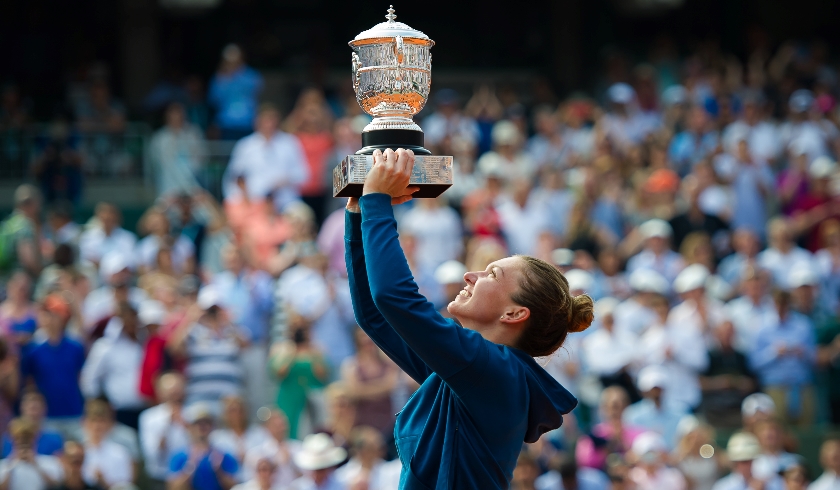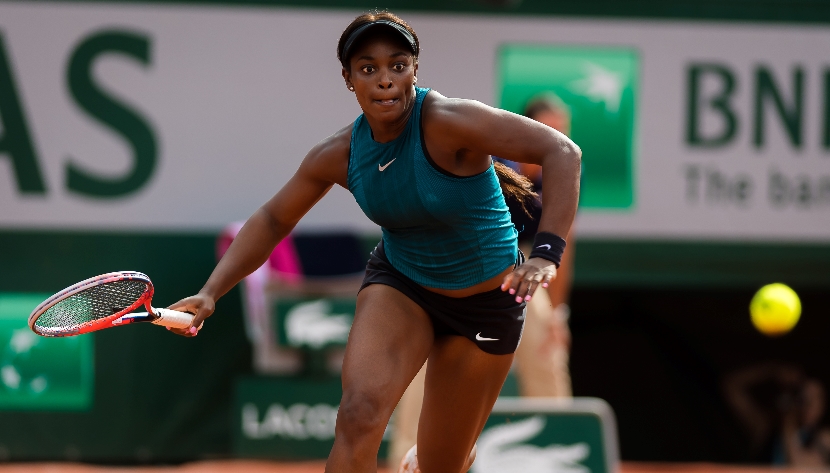Simona Halep defeats Sloane Stephens 3-6 6-4 6-1

There will be a number of well-written pieces focusing on the stories of Saturday’s two women’s finalists at Roland Garros, especially on Simona Halep who handed Sloane Stephens her first loss in the finals of a tournament by a score of 3-6 6-4 6-1.
Therefore, I will pass on that angle and jump straight into the nitty-gritty of what happened on the court over the course of the 2 hours and three minutes that it took for these two champions to carry the match to its conclusion.
When two exceptional baseline players like Halep and Stephens face each other, first few games are critical. One cannot afford to have a slow start, because that would not only mean that she is allowing the other to get ahead on the scoreboard, but it may also give her the false sense that the other player is better than her from the baseline – read that, beating her at her own game – and trick her into making a premature tactical adjustment.
Although both players made it through the first three games with around the same number of unforced errors**, Halep committed three of them in the third game alone, two in a row from 30-30 to lose her serve and go down 1-3. She started the next game with two more unforced errors which eventually led to Stephens confirming the break and going up 4-1. Sloane never relinquished the lead and took the first set 6-3.
**Usual disclaimer: I keep my own count of the unforced errors, double faults are not included.
Because of the timing of those few errors by Simona, Sloane led by a set in the scoreboard and appeared to be the superior baseliner up to that point in the match, holding precisely the kind of edge that I mentioned above.
Of course, I can never be sure of what exactly what goes through a player’s mind, but Halep already appeared to be looking for solutions in the latter part of the first set.
For example, during a long rally in the 15-15 point of the 4-2 game, Halep threw everything but the kitchen sink at Stephens in terms of varying the height and pace of her shots. She hit some shots with heavy topspin, added some mid-pace high-loopers, and squeezed in a flat, hard forehand. She won that point, but in the next one, Stephens answered right back with a dandy of a forehand. Then, Halep missed the return deep, and Stephens put the game away with a clean forehand winner.
Just like in that game, even when Halep found a pattern that temporarily worked, she struggled to replicate it point after point against a player who is on fire. All those rallies in the first set must have felt to Stephens like they were taking place in the comfort of her living room, simply because she had the lead. I remind everyone that she did not start out that way, committing six unforced errors in the first two games. If you think she played a flawless first set, think again. She played a flawless after she got the lead at 3-1. In fact, if you watch the first two games and the last four in that set, you would believe that it’s a 50-50 affair.
However, context is everything, and the first set did not feel like it went neck-to-neck. Stephens appeared to be dominating. So, Halep looked for answers in her bag of solutions. She did not lose her cool** and pursued different paths to come up with a working formula, even though Stephens was operating as smoothly as possible.
**Let’s please put the “she freezes” or the “she crumbles under the moment” narrative away for good.
Again, this is my observation and I cannot know for sure what goes through a player’s head, but as soon as the second set began, it appeared as if Halep turned extremely aggressive and began nailing as many shots as possible.
The problem was that, in her attempt to play a riskier brand of tennis, she either went for some low-percentage shots and missed (see the 15-15 point in the first game, when she tried to hit too perfect a forehand down-the-line while backing up far behind the baseline) or Sloane produced some five-star counterpunches to negate Simona’s aggressiveness (see the very next point at 15-30, Halep hits three high-octane shots in a row, but Sloane gets them back and puts the fourth one away with a backhand down-the-line rocket. See also the second deuce point in the same game for yet another such example).
Down 3-6 0-2, Simona persevered and dug even deeper for a solution. She tried moving forward on floaters, winning three points in that game thanks to swing-volleys. She held serve, but she was still down a set and a break. There was no doubt that her on-court IQ was in overdrive and calculations would not end until she found one.
Until that point, Halep used mixed patterns for the most part (whether consciously or unconsciously, I don’t know), meaning that, she did not specifically work Stephens’s forehand or backhand, but switched back and forth a lot, targeting the open spots (see the 30-15 point at 5-2 in the first set if you prefer to see an example). No “triangle patterns”** were to be found in her shots.
** It is a term used – by some coaches and pros – to make allusion to the triangle trajectory of the ball going back-and-forth when one player stands on one side of the court and moves the other player around. The moving player is expected to run every ball down and send them back to the same corner on the other side. It’s your conventional consistency drill left over from the 70s and 80s that centers on building accuracy in your strokes while working on your stamina.
When Stephens was serving at 2-1, and Halep led 0-30, it was the first conspicuous use of triangle tennis that I saw in the second set. Halep hit seven shots in a row to Stephens’s backhand before accelerating the next one to her forehand. Stephens missed the forehand in the net. The seven shots hit by Halep were not intended to be winners. In fact, a couple of them were mid-pace, topspin shots that Sloane could easily send back. When time came to step in and accelerate for Halep though, she went after Sloane’s forehand and collected the error.
Halep began to adopt this pattern more and more frequently during rallies.
Granted, Stephens put together her worst sequence from 2-1 up to 2-4 down in that second set and made a bunch of unforced errors. So, the turn-around cannot be attributed to Halep’s variation of the triangle by any means, but it must have helped her mentally to discover a pattern that works in her favor, because she repeatedly went back to it, even if she lost a few of those points (see the 30-0 point at 4-3 for Halep).
Halep played three more points using that pattern in the 4-4 game, working Sloane’s backhand side with mixed pace, then accelerating to her forehand side. In the 15-0 point of the 5-4 game, Halep hit five shots to the ad side, four of them being regular-paced deep shots, and two accelerations to Sloane’s forehand side, the second of which collected an error from the American’s racket.

Halep began the final set in the same vein as she looked to force the same pattern in five out of six points in the first game (the other one was a return miss by Stephens). Again, Sloane’s deuce side of the court was only targeted for accelerations. Otherwise, Halep kept a steady flow of clean, measured, topspin shots coming to Sloane’s backhand side. On the 40-30 point, Halep hit five “safe” but deep shots to Stephens’s backhand and followed it up with another acceleration to her forehand. Stephens’s forehand clipped the net and kicked up, giving the advantage to Halep. Two shots later, Halep put the ball away and led 1-0 in the third.
In the second game, three more points were directed in this pattern by Halep. At 30-40, she sent another high topspin to Sloane’s backhand corner and got a short ball back from the American. She stepped in and nailed the ball to the deuce side. Sloane got to it but returned the defensive forehand in the net. Halep now led 2-0.
In the last point of the next game, Halep hit seven out of the last ten shots to Stephens’s backhand side (only accelerating one) and hit the other three hard to her forehand side. The point ended with an error by Stephens. Halep now led 3-0.
I could go on and on with more examples, but you get the idea. If you thought that Stephens’s backhand was a major problem for her in this match because of the amount of errors she committed (12 forehands, 21 backhands by my count – officially it’s 13 and 25), you were only partially right. When using this pattern, Halep actually banked on collecting errors from her forehand side, especially on the accelerations. It worked more than once, on important points.
This also took away one of Stephens’s favorite activities, which is to hit counterpunches on the move. Instead, she remained static in one spot for a string of two or three shots (or more) and engaged in rallies where she had to fabricate the pace, or else she would find herself under pressure when she hit a short ball.
Fans of Stephens must be disappointed, and they are probably focusing on the three bad games in the middle portion of the second set. They are right in that Sloane’s level did go down. But surely, it would have been too optimistic to expect her to stay at the level she played during the first hour.
Plus, Halep’s come-back win cannot be entirely attributed to the three-game bad streak by Stephens. Halep deserves a lot of credit because she remained cool-headed while trailing for almost 45 minutes against an opponent who was not only playing high-quality tennis but also answering the call every time Halep made an adjustment in an attempt to turn the match around. Halep persisted, persevered, persisted, and won.
If anyone has anything to say to me about Halep lacking on-court IQ from this moment forward, they can bet that I will throw the “Roland Garros 2018 final” card right back at them.

Mert,
I like what Darren Cahill said after the match. He said “Difficult roads often lead to beautiful destinations. This one is beyond the best. Thank you Simona Halep”
Also when you get a chance, listen to the interview where Pat Cash asked Darren a lot of interesting questions about coaching. The interview is on Pat Cash’s twitter account.
I personally rate Cahill as one of the top 5 coaches on the circuit. Do you agree?
Umit
I agree totally. His record speaks for itself (Hewitt, Agassi, Halep) and he is a delight to listen to when he commentates about tactics. I will check Cash’s interview with him as soon as I can find the time. Thanks Umit.